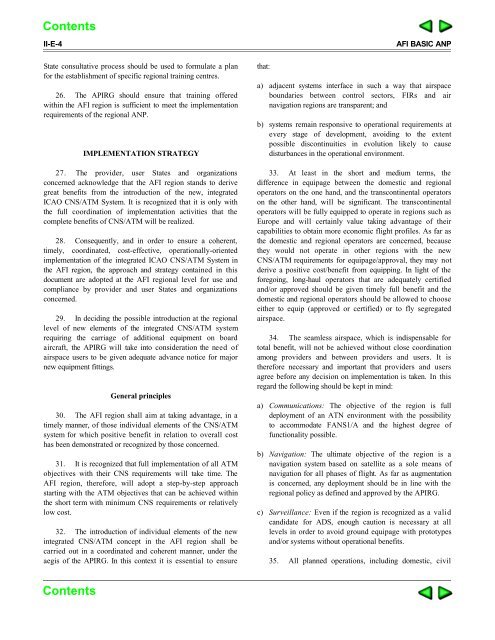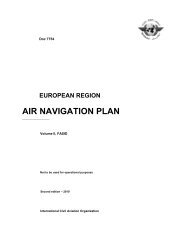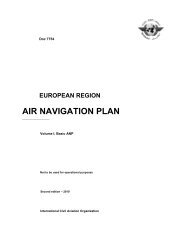introduction - ICAO Public Maps
introduction - ICAO Public Maps
introduction - ICAO Public Maps
You also want an ePaper? Increase the reach of your titles
YUMPU automatically turns print PDFs into web optimized ePapers that Google loves.
II-E-4<br />
State consultative process should be used to formulate a plan<br />
for the establishment of specific regional training centres.<br />
26. The APIRG should ensure that training offered<br />
within the AFI region is sufficient to meet the implementation<br />
requirements of the regional ANP.<br />
IMPLEMENTATION STRATEGY<br />
27. The provider, user States and organizations<br />
concerned acknowledge that the AFI region stands to derive<br />
great benefits from the <strong>introduction</strong> of the new, integrated<br />
<strong>ICAO</strong> CNS/ATM System. It is recognized that it is only with<br />
the full coordination of implementation activities that the<br />
complete benefits of CNS/ATM will be realized.<br />
28. Consequently, and in order to ensure a coherent,<br />
timely, coordinated, cost-effective, operationally-oriented<br />
implementation of the integrated <strong>ICAO</strong> CNS/ATM System in<br />
the AFI region, the approach and strategy contained in this<br />
document are adopted at the AFI regional level for use and<br />
compliance by provider and user States and organizations<br />
concerned.<br />
29. In deciding the possible <strong>introduction</strong> at the regional<br />
level of new elements of the integrated CNS/ATM system<br />
requiring the carriage of additional equipment on board<br />
aircraft, the APIRG will take into consideration the need of<br />
airspace users to be given adequate advance notice for major<br />
new equipment fittings.<br />
General principles<br />
30. The AFI region shall aim at taking advantage, in a<br />
timely manner, of those individual elements of the CNS/ATM<br />
system for which positive benefit in relation to overall cost<br />
has been demonstrated or recognized by those concerned.<br />
31. It is recognized that full implementation of all ATM<br />
objectives with their CNS requirements will take time. The<br />
AFI region, therefore, will adopt a step-by-step approach<br />
starting with the ATM objectives that can be achieved within<br />
the short term with minimum CNS requirements or relatively<br />
low cost.<br />
32. The <strong>introduction</strong> of individual elements of the new<br />
integrated CNS/ATM concept in the AFI region shall be<br />
carried out in a coordinated and coherent manner, under the<br />
aegis of the APIRG. In this context it is essential to ensure<br />
that:<br />
AFI BASIC ANP<br />
a) adjacent systems interface in such a way that airspace<br />
boundaries between control sectors, FIRs and air<br />
navigation regions are transparent; and<br />
b) systems remain responsive to operational requirements at<br />
every stage of development, avoiding to the extent<br />
possible discontinuities in evolution likely to cause<br />
disturbances in the operational environment.<br />
33. At least in the short and medium terms, the<br />
difference in equipage between the domestic and regional<br />
operators on the one hand, and the transcontinental operators<br />
on the other hand, will be significant. The transcontinental<br />
operators will be fully equipped to operate in regions such as<br />
Europe and will certainly value taking advantage of their<br />
capabilities to obtain more economic flight profiles. As far as<br />
the domestic and regional operators are concerned, because<br />
they would not operate in other regions with the new<br />
CNS/ATM requirements for equipage/approval, they may not<br />
derive a positive cost/benefit from equipping. In light of the<br />
foregoing, long-haul operators that are adequately certified<br />
and/or approved should be given timely full benefit and the<br />
domestic and regional operators should be allowed to choose<br />
either to equip (approved or certified) or to fly segregated<br />
airspace.<br />
34. The seamless airspace, which is indispensable for<br />
total benefit, will not be achieved without close coordination<br />
among providers and between providers and users. It is<br />
therefore necessary and important that providers and users<br />
agree before any decision on implementation is taken. In this<br />
regard the following should be kept in mind:<br />
a) Communications: The objective of the region is full<br />
deployment of an ATN environment with the possibility<br />
to accommodate FANS1/A and the highest degree of<br />
functionality possible.<br />
b) Navigation: The ultimate objective of the region is a<br />
navigation system based on satellite as a sole means of<br />
navigation for all phases of flight. As far as augmentation<br />
is concerned, any deployment should be in line with the<br />
regional policy as defined and approved by the APIRG.<br />
c) Surveillance: Even if the region is recognized as a valid<br />
candidate for ADS, enough caution is necessary at all<br />
levels in order to avoid ground equipage with prototypes<br />
and/or systems without operational benefits.<br />
35. All planned operations, including domestic, civil














